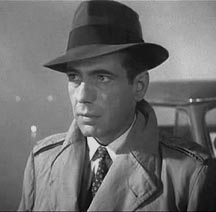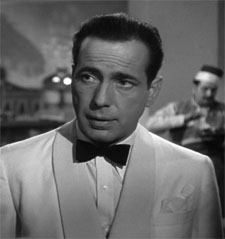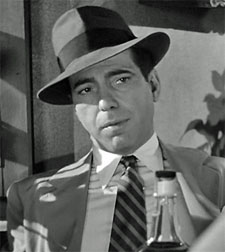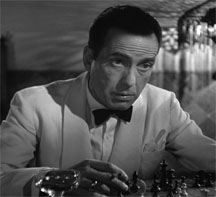|
Humphrey Bogart as Rick
Blaine
Quote: "I'm
no good at being noble, but it doesn't take much to see that the
problems of three little people don't amount to a hill of beans in this
crazy world. Someday you'll understand that. Now, now...Here's looking
at you kid."
- Rick convincing Ilse to get on the plane.
 There has been a number of rumors through the years that Bogart was not
the studios choice to play the part of Rick Blaine. Other actors like
Ronald
Reagan or George Raft were considered first for the part. This simply
is
not true. Bogart was producer Hal B. Wallis' only choice to play
Blaine.
In fact, he was writing the part for Bogart. The rumor comes out of
some
old studio publicity done at the time to promote various actors.
There has been a number of rumors through the years that Bogart was not
the studios choice to play the part of Rick Blaine. Other actors like
Ronald
Reagan or George Raft were considered first for the part. This simply
is
not true. Bogart was producer Hal B. Wallis' only choice to play
Blaine.
In fact, he was writing the part for Bogart. The rumor comes out of
some
old studio publicity done at the time to promote various actors.
Born Humphrey DeForest Bogart on December 25, 1899 (there was a
little controversy on the date) in New York City, the oldest of three.
He was the son of a Manhattan surgeon and a magazine illustrator (in
fact,
she used a drawing of her baby Humphrey in a well-known ad campaign for
Mellins Baby Food - not Gerber's, which debunks another myth). He had a
tough childhood with both parents being alcoholics. Bogart was educated
at Trinity School, in New York City and then was sent to Phillips
Academy
in Andover, Massachusetts. Though a poor student, Bogart was a lifelong
reader. He could quote Plato, Pope, Ralph Waldo Emerson and over a
thousand
lines of Shakespeare. The hope was for Bogart to pursue a medical
career
like his father. This didn't work out as planned as he was expelled
from
Phillips Academy (for smoking) in 1918 and joined the U.S. Navy.
According
to one story, while in the Navy, he was wounded in the shelling of the
Leviathan; the resulting partial paralysis caused his signature snarl
and
lisp (there are a number of other stories of how the injury occurred).
From 1920 to 1922, he managed a stage company owned by family friend
William
S. Brady, performing a variety of tasks at Brady's film studio in New
York.
His acting career began shortly after this. His first role was
portraying
a Japanese butler (that must have been a stretch). It was his friend
Spencer
Tracy that gave him the nickname, "Bogie."
1924, Bogart married his
first wife, Helen Menken, which ended in divorce a year later (though
they
remained friends). In 1928, he married Mary Philips (who went on to
appear
in 20 movies - including A
Farewell
to Arms in 1932) and divorced her ten years later in 1938 when she refused to follow
him from Broadway to Hollywood. Four
months later, he married actress Mayo Methot (who appeared in 28 movies
herself). This was a very tumultuous marriage. Their fights became
famous
and they became known as the "Battling Bogarts." During this time,
Bogart bought a sailboat, which he named "Sluggy" after his
hot-tempered wife. He divorced her in
1945
to marry actress Lauren Bacall. They had appeared together in To
Have and Have Not in 1944 when she was 19 years old. Bogart and
Bacall moved into a $160,000 white brick mansion in Holmby Hills, an
exclusive neighborhood between Beverly Hills and Bel-Air. They would
be happy together until his death. years later in 1938 when she refused to follow
him from Broadway to Hollywood. Four
months later, he married actress Mayo Methot (who appeared in 28 movies
herself). This was a very tumultuous marriage. Their fights became
famous
and they became known as the "Battling Bogarts." During this time,
Bogart bought a sailboat, which he named "Sluggy" after his
hot-tempered wife. He divorced her in
1945
to marry actress Lauren Bacall. They had appeared together in To
Have and Have Not in 1944 when she was 19 years old. Bogart and
Bacall moved into a $160,000 white brick mansion in Holmby Hills, an
exclusive neighborhood between Beverly Hills and Bel-Air. They would
be happy together until his death.
After a number of small
roles, Bogart's break came in 1936. Two years earlier, Bogart starred
in the play Invitation to a Murder.
Producer Arthur Hopkins saw the play and wanted Bogart when he chose to
produce Robert E. Sherwood's new play, The Petrified Forest for Broadway.
Bogart originaly thought he was better suited to play the part of the
football player/gas attendent. However, he was cast in the role of
escaped killer/gang leader
Duke
Mantee. The show, with Leslie Howard playing the lead, had 197
performances. Warner Bros. bought the screen rights to The Petrified Forest and signed up
Leslie Howard. The studio wanted veteran actor Edward G. Robinson for
the Duke Mantee role. Howard insisted that Bogart play Duke Mantee.
When Warner Bros. saw that Howard would not budge, they gave in and
gave him the role. Bogart was always grateful that Howard stuck up for
him
and later in 1952 named his only daughter, Leslie, after Howard (who
had died during World War II).
This would be the
start of a string of gangster/tough guy roles for Bogart along with a
contract
with Warner Brothers Studios. From 1936 to 1940, he appeared in 28
movies
(averaging two a month), such as Angles
with Dirty Faces with James Cagney (who shoots him in the
movie). In his movie career as a
tough
guy/gangster, he went to the electric chair 12 times. He didn't like
the
roles he always got, such as Swing
Your Lady and The Return of
Doctor X, but in those days you couldn't choose the roles
you
played, you just did what the studio told you to do.
In 1937, Bogart received a
substantial leading role in Samuel Goldwyn's Dead End. He also appeared that
year as Frank Taylor, his first lead in an "A" feature, in Warner Bros.
anti-Klan, and in a bigger sense anti-Nazi, movie Black Legion in 1937.
His big year
came in 1941, when he played the part of the villain, Roy 'Mad Dog'
Earle
in Raoul Walsh's High Sierra
(it also
featured Bogart's own dog in the movie) which was written by Bogart's
friend
and drinking partner, John Huston and later as Sam Spade in the The
Maltese Falcon. James Cagney and George Raft had both turned
down
Bogart's part in High Sierra; Raft didn't want to play a character who
died at the end. Then Raft turned down the lead in John Huston's
directorial
debut, The Maltese Falcon.
In this film, he would team up with future Casablanca
co-stars Sidney Greenstreet and Peter Lorre (the first of four movies
the
three would appear in together). Finally, he didn't play the bad guy,
but
a tough detective who had a great line when he turned his murderess
client
(Mary Astor) in to the police, "I don't care who loves you. I won't
play
the sap for you! You killed Miles and you're going over for it. I hope
they don't hang you by your sweet neck. If you're a good girl, you'll
be
out in 20 years and you'll come back to me. If they hang you, I'll
always
remember you."
 The following
year, at the age of 42, he was given his first serious romantic lead in Casablanca. He
put a lot of himself into the character of Rick Blaine, the soured
idealist,
loner and hard-drinking man on the run from some mysterious past. Rick
Blaine was even a chess player which Bogart was in real life (one level
below master level). This was
the only film that he and co-star Ingrid Bergman did together and he
was
paid $36,667. They had great onscreen chemistry, however, it ended
there.
Off the set, Bergman and Bogart hardly spoke during filming. She said
later, "I kissed him but I never knew him."
Bogart did make friends with other actors like Claude Rains, the
sincere friendship that Rick and Louis have on set was very real
between Bogart and Rains, and was already friends with Peter Lorre, his
partner in crime when it came to playing practical jokes.
The following
year, at the age of 42, he was given his first serious romantic lead in Casablanca. He
put a lot of himself into the character of Rick Blaine, the soured
idealist,
loner and hard-drinking man on the run from some mysterious past. Rick
Blaine was even a chess player which Bogart was in real life (one level
below master level). This was
the only film that he and co-star Ingrid Bergman did together and he
was
paid $36,667. They had great onscreen chemistry, however, it ended
there.
Off the set, Bergman and Bogart hardly spoke during filming. She said
later, "I kissed him but I never knew him."
Bogart did make friends with other actors like Claude Rains, the
sincere friendship that Rick and Louis have on set was very real
between Bogart and Rains, and was already friends with Peter Lorre, his
partner in crime when it came to playing practical jokes.
Bogart earned an
Oscar nomination in 1943, however he lost out to
Hungarian
actor Paul Lukas who starred in Watch
on the Rhine. Bogart made three other films in 1943: Sahara,
Action in the North Atlantic and Thank
Your Lucky Stars.
In 1944, he
played Jean Matrac, a former French journalist who is outraged
by
France's pre-war appeasement of the Nazi's and later wrongly convicted
to Devil's Island in Passage
to Marsailles which was produced by Hal B. Wallis and directed
by
Michael Curtiz. Later he escapes and eventually becomes a flyer
in the Free-French Air Force and is killed in a bombing mission over
Germany.
In the movie, Bogart is again
reunited
with his Casablanca
co-stars;
Lorre, Rains, Dantine and Greenstreet.
In 1947,
he joined Lauren Bacall and others protesting the witch hunts of the
House
Un-American Activities Committee. Bogart was not, however, prepared to
deal with the industry pressure to abandon this campaign; within a year
he disavowed his activities, retreating to his role as actor and
apologizing
for speaking out on politics.
He played
other great roles. In 1948, as Fred C. Dobbs in The
Treasure of the Sierra Madre. Bogart played Frank McCloud in
John
Huston's Key Largo with
Edward G. Robinson and his future wife Lauren Bacall - (the last of
their
four movies together). Casablanca
actors Dan Seymour, Monte Blue and Alberto Morin also had parts in this
movie. Bogart has a great line in this movie when he confronts gangster
Johnny Rocco (Robinson) when they are all trapped in a hotel during a
hurricane.
He tells Rocco, who is becoming agitated over the storm, "You don't
like
it, do you Rocco, the storm? Show it your gun, why don't you? If it
doesn't
stop, shoot it." In 1949, he played a lawyer defending a young
inner-city murder suspect in Knock
on Any Door. In this movie, his former Casablanca co-star Dooley
Wilson is back at the piano.
In 1951,
Bogart
played gin-swilling riverboat captain Charlie Allnut in John
Huston's The
African Queen, where he starred with Catherine Hepburn, who he
calls in the movie, a "crazy, psalm-singing, skinny old maid!", and won
his
only Academy Award (Oscar). He beat out other great actors like Marlon
Brando (Streetcar Named Desire),
Fredric March (Death of a Salesman)
and Montgomery Clift (A Place in the
Sun). Filming this movie caused him to travel to Africa where
just about everyone in the cast came down with dysentery except Bogart
and John Huston (Bogart claims it was because of all of the scotch he
drank). This was the first of only five Technicolor films in which
Bogart appeared in (the other color films included The Caine Mutiny,
The Barefoot Contessa, We're No Angels, and The Left Hand of God.) Also
in 1951, Bogart and Bacall co-starred in the syndicated radio drama Bold Venture, for which he was paid
a reported $4,000 a week.
In 1954, while
feeling the effects of the throat cancer that would take his life, he
portrayed
Captain Queeg in The Caine Mutiny
with Van Johnson and Fred MacMurray. Bogart was nominated for an Oscar
for the third time for this role, but lost to Marlon Brando who starred
in On the Waterfront.
Later
that year, he portrayed Linus in Sabrina
with Audrey Hepburn and William Holden. In 1956, he appeared in his
75th
and final movie portraying a has been sportswriter in The
Harder They Fall with Rod Steiger. He was voted the Greatest
Movie
Star of all time by Entertainment Weekly and ranked #1 on the American
Film Institute's list of the greatest screen actors. Two Bugs Bunny
cartoons featured Bogart including one where Bugs Bunny decides to take
a baby penguin back to the South Pole; at intervals throughout the
cartoon, "Fred C. Dobbs" (Bogart's character in Treasure of the Sierra
Madre) appears and asks Bugs to "help a poor American down on his
luck." Bugs always flips him a coin and in a Bogart fashion says,
"hit the road." In the end, the Bogart character gets the penguin.
 Bogart never took care of himself. He drank heavily and smoked
unfiltered
Chesterfields. As his health failed, he finally went to a doctor and
found
out he had cancer of the esophagus. He died in his sleep, at the age of
57, in his Hollywood home on January 14, 1957. His wife, Lauren Bacall,
placed a small gold whistle in his coffin. This was from their first
movie
together when Bacall said the famous line to Bogart, "You know how to
whistle,
don't you, Steve? Just put your lips together, and blow." His funeral
was
held at All Saints Episcopal Church with musical selections played from
Bogart's favorite composers, Johann Sebastian Bach and Claude Debussy.
John Huston who gave the eulogy said, "He is quite irreplaceable. There
will never be another like him." In 1999, the American Film Institute
named
Humphrey Bogart the Greatest Male Star of All Time.
Bogart never took care of himself. He drank heavily and smoked
unfiltered
Chesterfields. As his health failed, he finally went to a doctor and
found
out he had cancer of the esophagus. He died in his sleep, at the age of
57, in his Hollywood home on January 14, 1957. His wife, Lauren Bacall,
placed a small gold whistle in his coffin. This was from their first
movie
together when Bacall said the famous line to Bogart, "You know how to
whistle,
don't you, Steve? Just put your lips together, and blow." His funeral
was
held at All Saints Episcopal Church with musical selections played from
Bogart's favorite composers, Johann Sebastian Bach and Claude Debussy.
John Huston who gave the eulogy said, "He is quite irreplaceable. There
will never be another like him." In 1999, the American Film Institute
named
Humphrey Bogart the Greatest Male Star of All Time.
Bogart's cremated ashes are interred at Forest
Lawn Memorial Park in Glendale, California, in the Garden of
Memory,
Columbarium of Eternal Light (not accessible to the general public). He
is a few feet away from actor Victor McLaglen (Gunga
Din).
There are more major Hollywood stars buried at Forest Lawn than at any
other spot in the world. It is a huge cemetery (over 300 acres) that
also
contains Casablanca
co-stars
Sydney Greenstreet, S.Z. Sakell, John Qualan along with producer Hal B.
Wallis, director Michael Curtiz and composer Max Steiner. Other famous
actors and actresses like Joan Blondell, Clara Bow, Clark Gable, Carole
Lombard, Jimmy Stewart, Jean Harlow, Mary Pickford, Errol Flynn,
Spencer
Tracy, George Burns & Gracie Allen, W.C. Fields, Sammy Davis Jr.,
Walt
Disney, Red Skelton, Robert Young, Lon Chaney, Alan Ladd, Ted Knight,
Sam
Cooke, Nat King Cole and Chico Marx are also buried here. They even
have
a small chapel that they perform weddings in. Ronald Reagan and Jane
Wyman
got married here in 1940.
The
Official Site of Humphrey Bogart
Tribute
to Humphrey Bogart (excellent site)
The
Bogart Site
Humphrey
Bogart's Hollywood
Grave
Photo
List
of
Usual Suspects
|